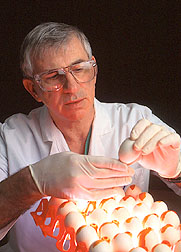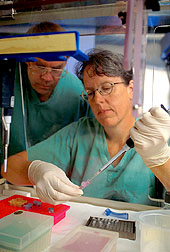Newcastle Disease: Protecting Poultry Farmers on Two Fronts
Newcastle disease has plagued poultry producers for 75 years. Strains native to the United States cause only mild symptoms—akin to a "common cold" for poultry. But exotic strains can cause devastating losses in other countries—and in the United States, if they invade via smuggled birds or wild birds, such as cormorants.
Keeping tabs on hazardous forms of Newcastle disease is a responsibility of USDA's Animal and Plant Health Inspection Service, which collaborates closely with the Agricultural Research Service.
Newcastle disease surfaced in this country in the 1930s. By the late 1940s, scientists had developed vaccines. They had also identified virus strains that produced symptoms in poultry ranging from mild to fatal. But identifying the differences in virus strains that explain their differing severity remains a challenge.
At ARS' Southeast Poultry Research Laboratory in Athens, Georgia, veterinarian Daniel J. King and microbiologist Bruce S. Seal work to keep U.S. poultry farmers protected on two fronts. Seal studies the genetic component of Newcastle virus samples sent in by APHIS. King studies how these viruses sicken and kill birds.
"Ultimately," says King, "we hope this combined approach will lead to better detection methods, so live birds don't have to be used to identify the virulence, or disease-causing ability, of new strains."
During 1971, a particularly nasty Newcastle strain from pet birds struck the poultry industry in California. Eradication took over 2 years and cost $56 million in federal funds. Nearly 12 million birds had to be destroyed.
In Seal's lab, analyses of gene sequences within the last few years helped confirm scientists' long-suspected connection between this outbreak and infected imported parrots. Some birds—particularly in the parrot family—can appear healthy even while harboring a virulent Newcastle strain.
Border Alert!
After the California outbreak, APHIS established quarantine stations to stop infected pet birds from entering the country.
The stations and other APHIS actions have protected U.S. poultry, despite ever-present threats. Virulent Newcastle strains have been detected in U.S. pet bird populations in all but 3 years since 1974. In addition, virulent Newcastle virus periodically flares up in other countries. In 1998, Australia began battling a virulent strain that apparently evolved from a weak virus indigenous to Australian poultry for at least 30 years.
Meanwhile, making sure all of America's pet parrots are "born in the USA" won't remove Newcastle's threat to this country. Wild birds can also carry strains deadly to poultry.
In 1992, 26,000 turkeys in North Dakota were destroyed after APHIS diagnosed virulent Newcastle disease in the flock. Cormorants were the suspected source. Hundreds had died from the disease at a lake near where the turkeys were being reared on range. Seal confirmed this suspicion when he compared the genomes of turkey and cormorant isolates.
The episode was part of the United States' first known Newcastle-related die-off of free-ranging wild birds.
International Implications
Besides directly threatening U.S. poultry, Newcastle can damage our export markets. In 1998, several dead and dying game chickens from a backyard flock in California's Central Valley were delivered by the owner to the California Veterinary Diagnostic Laboratory in Fresno. APHIS' National Veterinary Services Laboratories in Ames, Iowa, confirmed the birds were infected with exotic Newcastle disease.
In accordance with international trade law, the incident was reported to the Office of International Epizootic Diseases in Paris, France. Some countries instituted a temporary ban on imports from the region until the outbreak was eradicated. The ban cost area poultry producers hundreds of thousands of dollars.
"Newcastle disease may not be a household word," says King. "But you can see why it's a big concern to the poultry industry. Each time APHIS sends us a strain with unique characteristics, we can understand the virus better."
A recent case illustrates how this partnership works.
In 1993, an anhinga—a wild water bird native to the Southeast—was found dead among a captive population in a Florida theme park. Samples from the bird were sent to APHIS microbiologist Dennis Senne in Ames. He confirmed the virus was Newcastle.
Senne also evaluated the strain's potential virulence, using a standard test that determines how quickly a strain kills chicken embryos. The result: While the strain was not extremely virulent, neither was it as weak as a common cold. Senne then sent a sample to King.
"Our job is basic diagnosis," Senne says. "But we often see isolates that come from interesting sources or seem unusual in their ability to cause disease. On the front lines, we don't have time to study these samples in detail. We rely on Jack King, Bruce Seal, and others to tell us where these different strains might be coming from and what kind of threat they might pose."
Senne's samples of anhinga virus arrived at the Athens laboratory by overnight express. Seal discovered that the anhinga isolate appeared almost identical to the one that killed the North Dakota turkeys. But while the genetic code was potentially ominous, King found that the anhinga strain's virulence was only moderate.
The ARS scientists deposited the anhinga strain's genetic code into international databases, such as Genbank, designed for accumulating nucleic acid sequences. Through the databases, researchers worldwide can quickly share new genetic information when viral samples are not available.
"The anhinga case demonstrates the value of our two-step approach," says King. "The genetic coding alone, or the clinical study alone, is not enough. We can know more about what a virus can do by joining the two approaches—the molecular and the clinical."
That approach continues in studies of new isolates from domestic poultry, imported doves, pheasants, and other birds.—By Jill Lee, formerly with ARS.
This research is part of Animal Health, an ARS National Program (#103) described on the World Wide Web at http://www.nps.ars.usda.gov/programs/appvs.htm.
Daniel J. King and Bruce S. Seal are with the USDA-ARS Southeast Poultry Research Laboratory, 934 College Station Rd., Athens, GA 30605; phone (706) 546-3434, fax (706) 546-3161.
"Newcastle Disease: Protecting Poultry Farmers on Two Fronts" was published in the October 1999 issue of Agricultural Research magazine.








